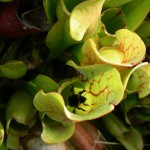Some carnivorous plants hold ‘pools’ within the plant consisting of rainwater and secreted substances such as sugars, used to lure and trap insect prey. Microscopic analysis of this fluid collected from pitcher plants (Sarracenia sp.) and bromeliads (Brocchinia sp.) growing in BU’s Biodome has revealed a rich diversity of single-celled microorganisms. These microbes, less than half a millimetre in length, are known as ciliates and distinguished by hair-like cilia that they use for locomotion and feeding.
Ciliates are incredible important grazers, feeding on bacteria, algae and organic matter, and are crucial part of the microecosystem within the bromeliad and pitcher plant pools, which also includes algae, bacteria and insect larvae and copepods that also grow in such pools, playing an important role in energy transfer from microbes to animals.

One of the microbes found within the pools was the the ciliate Euplotes, pictured about. Copyright Jack Dazley
 Eating out in Britain: the feeding habits of non-native pitcher plants
Eating out in Britain: the feeding habits of non-native pitcher plants Hidden Microbes in Christchurch House “Pond”
Hidden Microbes in Christchurch House “Pond” The secret information hidden in your hair
The secret information hidden in your hair










 New Nepal scoping review on maternal & neonatal health
New Nepal scoping review on maternal & neonatal health Fourth INRC Symposium: From Clinical Applications to Neuro-Inspired Computation
Fourth INRC Symposium: From Clinical Applications to Neuro-Inspired Computation Writing policy briefs
Writing policy briefs Upholding Excellence: The Concordat to Support Research Integrity
Upholding Excellence: The Concordat to Support Research Integrity ECR Funding Open Call: Research Culture & Community Grant – Application Deadline Friday 12 December
ECR Funding Open Call: Research Culture & Community Grant – Application Deadline Friday 12 December MSCA Postdoctoral Fellowships 2025 Call
MSCA Postdoctoral Fellowships 2025 Call ERC Advanced Grant 2025 Webinar
ERC Advanced Grant 2025 Webinar Horizon Europe Work Programme 2025 Published
Horizon Europe Work Programme 2025 Published Horizon Europe 2025 Work Programme pre-Published
Horizon Europe 2025 Work Programme pre-Published Update on UKRO services
Update on UKRO services European research project exploring use of ‘virtual twins’ to better manage metabolic associated fatty liver disease
European research project exploring use of ‘virtual twins’ to better manage metabolic associated fatty liver disease